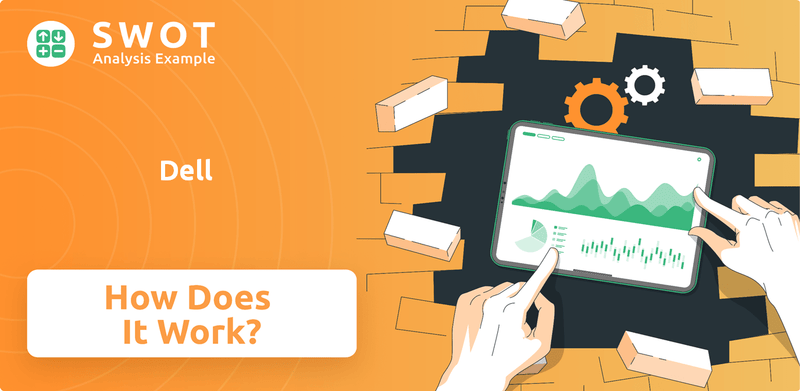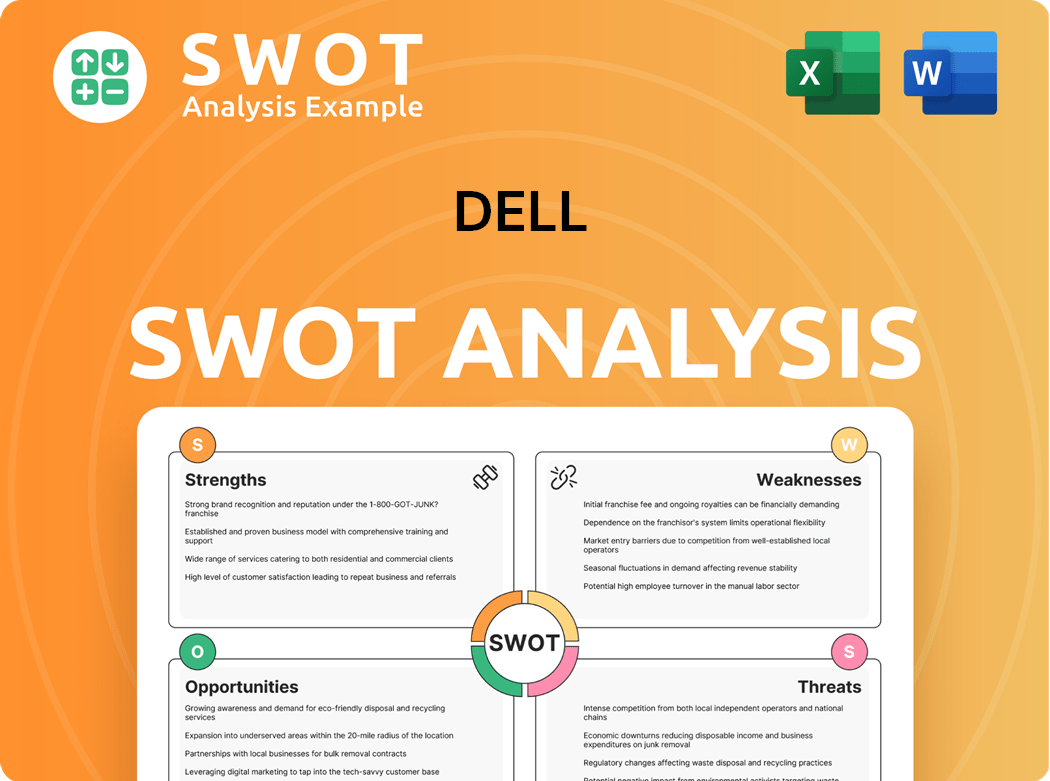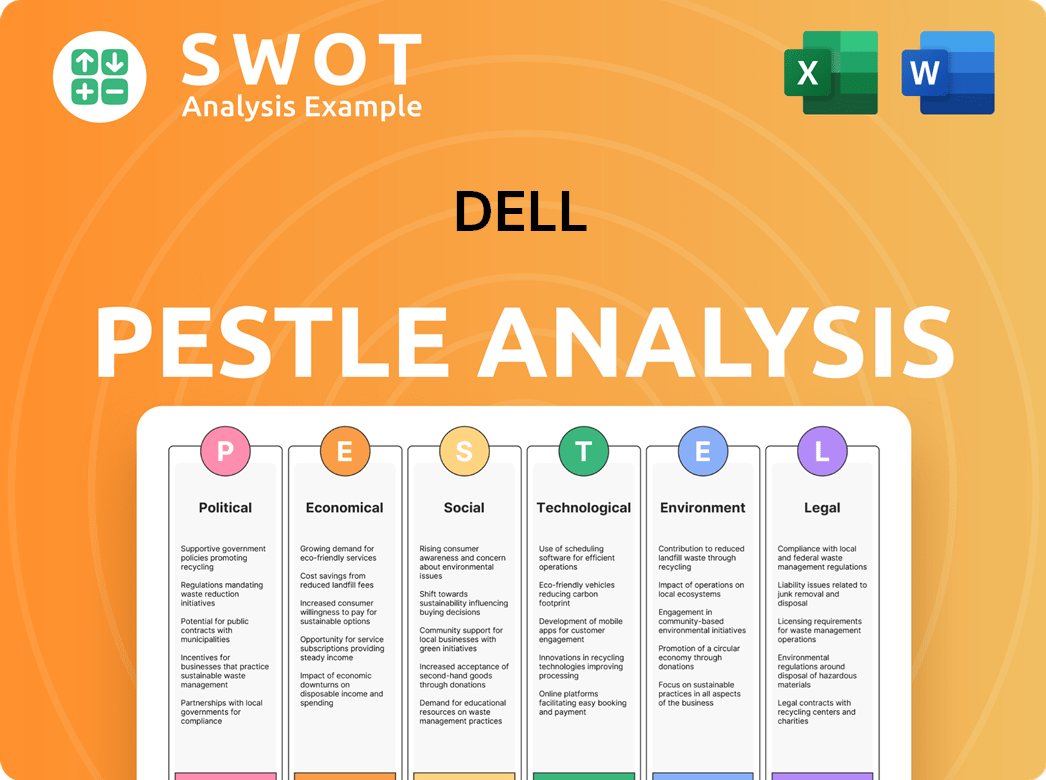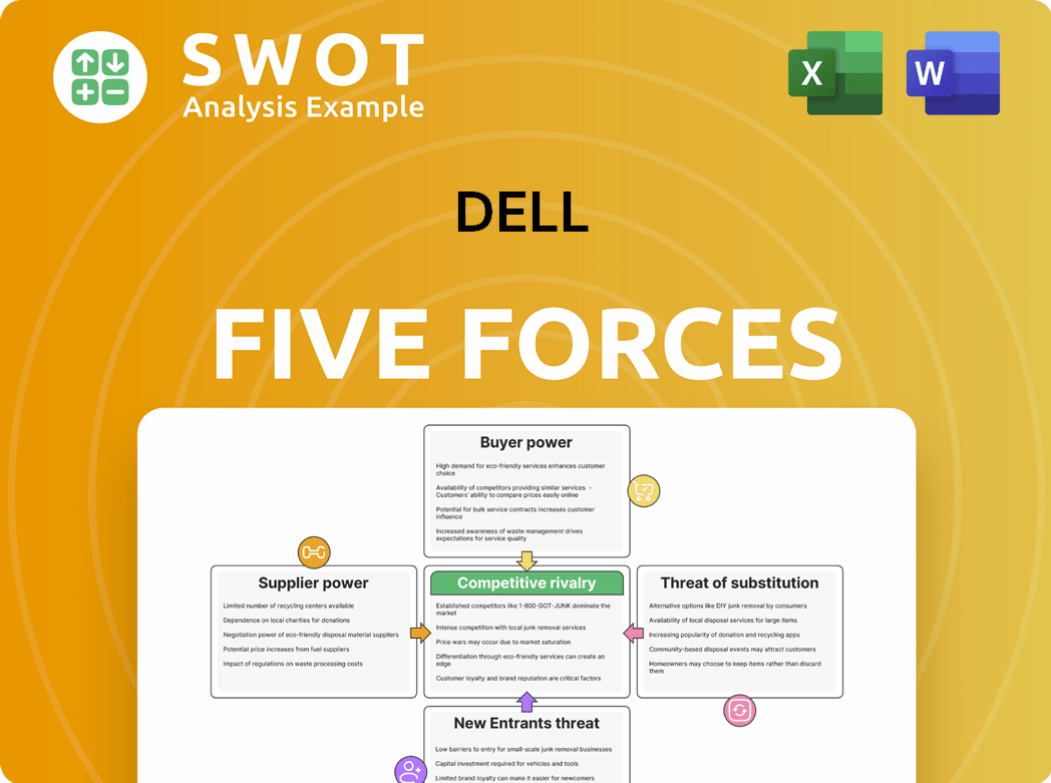Dell Bundle
How Does Dell Thrive in the Tech World?
Dell, a tech industry giant, has revolutionized computing since its inception. From pioneering direct sales to becoming a comprehensive IT solutions provider, Dell SWOT Analysis reveals the company's strategic prowess. Its impressive financial results, such as the $88.4 billion in revenue for fiscal year 2024, highlight its enduring influence and market dominance.

Understanding how Dell company operates is crucial for investors, customers, and industry analysts. This exploration into How Dell works will dissect Dell's business model, examining its complex operations, from its supply chain to its diverse revenue streams. We'll uncover how Dell products have shaped the tech landscape and how the company continues to innovate and compete in a dynamic global market, providing a deep dive into Dell's financial performance overview and market share analysis.
What Are the Key Operations Driving Dell’s Success?
The core of the Dell company's operations and value proposition revolves around two main segments: the Client Solutions Group (CSG) and the Infrastructure Solutions Group (ISG). CSG focuses on providing desktops, laptops, and workstations, serving a diverse customer base from individual consumers to large enterprises. ISG offers servers, storage, and networking solutions, primarily targeting enterprise customers seeking robust IT infrastructure.
Dell's operational effectiveness is enhanced by its global sourcing, manufacturing, and a sophisticated supply chain. The company has evolved from its direct sales model to include a strong channel partner program, expanding its reach. This approach allows Dell to cater to a broader market, providing tailored solutions and comprehensive support.
Dell's commitment to technology development, with significant investments in research and development, drives innovation in areas like AI-powered PCs and advanced data storage solutions. This focus, combined with its efficient supply chain and extensive distribution networks, translates into significant customer benefits.
CSG offers a wide range of products, including desktops, laptops, and workstations. These products are designed for various users, from individual consumers to large businesses. This segment is a key revenue driver for Dell, providing essential computing solutions.
ISG focuses on providing servers, storage, and networking solutions. These offerings are crucial for enterprise customers who require robust IT infrastructure. The segment supports data centers and other critical IT operations.
Dell utilizes both direct sales and channel partners to reach its customers. The direct sales model provides a personalized experience, while channel partners expand the company's reach. This dual approach allows Dell to serve a wider customer base effectively.
Dell invests heavily in research and development to drive innovation. This includes advancements in AI-powered PCs and advanced data storage solutions. Innovation is a key factor in maintaining a competitive edge in the market.
Dell's operations are characterized by a focus on efficiency and customer satisfaction. The company's supply chain is a key differentiator, enabling efficient delivery and customization. This efficiency, combined with its extensive distribution networks and customer service capabilities, translates into significant customer benefits.
- Supply Chain: Dell's supply chain is designed for efficiency, enabling rapid delivery and customization of products. This is critical for meeting customer demands and maintaining a competitive advantage.
- Customer Service: Dell provides comprehensive support, including tailored solutions and reliable performance. Customer service is a key aspect of the value proposition, ensuring customer satisfaction and loyalty.
- End-to-End Solutions: Dell offers a wide range of products, from personal computing to complex data center infrastructure. This allows Dell to serve a broader customer base.
- Market Share: In Q1 2024, Dell held a significant market share in the global PC market, demonstrating its strong position. The company's focus on innovation and customer satisfaction contributes to its market share.
For more insights into the company's history and evolution, you can read about the Brief History of Dell.
Dell SWOT Analysis
- Complete SWOT Breakdown
- Fully Customizable
- Editable in Excel & Word
- Professional Formatting
- Investor-Ready Format

How Does Dell Make Money?
The Dell company generates revenue through a multifaceted approach, primarily centered on the sale of hardware, software, and services. This strategy is executed across two main segments: the Client Solutions Group (CSG) and the Infrastructure Solutions Group (ISG). The Dell business model leverages a combination of product sales and service offerings to maximize customer lifetime value and ensure recurring revenue streams.
For the full fiscal year 2024, Dell reported total net revenue of $88.4 billion, demonstrating its significant market presence. The company's revenue streams are diverse, reflecting its comprehensive portfolio of products and services designed to meet the needs of various customer segments, from individual consumers to large enterprises.
The Client Solutions Group (CSG) is a significant contributor to Dell's revenue, encompassing desktops, notebooks, and workstations. In fiscal year 2024, this segment generated $48.9 billion in revenue. This revenue is driven by sales of Dell products to consumers, businesses, and public sector organizations, highlighting the broad appeal of Dell's offerings.
The Infrastructure Solutions Group (ISG) focuses on servers, storage, and networking solutions, contributing substantially to Dell's overall financial performance. In fiscal year 2024, ISG generated $37.9 billion in revenue. Within ISG, servers and networking brought in $19.2 billion, and storage accounted for $18.7 billion. Dell's Dell's operations are structured to support these key revenue streams, ensuring efficient production, distribution, and customer support.
- Hardware Sales: This includes desktops, laptops, servers, storage devices, and networking equipment. This is a core revenue stream for the company, catering to both consumer and enterprise markets.
- Software Sales: Dell offers a range of software solutions, which contribute to its revenue.
- Services: Services include support, deployment, and consulting. These services provide recurring revenue and enhance customer relationships.
- Tiered Pricing: Dell uses tiered pricing for different product configurations to maximize revenue from various customer segments.
- Cross-selling: The company cross-sells complementary products and services to increase customer lifetime value.
Dell PESTLE Analysis
- Covers All 6 PESTLE Categories
- No Research Needed – Save Hours of Work
- Built by Experts, Trusted by Consultants
- Instant Download, Ready to Use
- 100% Editable, Fully Customizable

Which Strategic Decisions Have Shaped Dell’s Business Model?
The journey of the Dell company has been marked by significant milestones and strategic shifts. A pivotal moment was the 2013 decision to go private, allowing the company to reshape its operations away from short-term market pressures. This move facilitated long-term investments and strategic realignments, setting the stage for future growth. The acquisition of EMC in 2016 for approximately $67 billion was a game-changer, broadening Dell's capabilities in enterprise IT, especially in storage and virtualization, and establishing it as a key player in the hybrid cloud market.
Dell's operations have adapted to various challenges, including supply chain disruptions. The company has responded by diversifying its manufacturing locations and strengthening relationships with suppliers to build resilience. These actions have been crucial in maintaining its competitive edge in a dynamic market. The company's ability to navigate these challenges is a testament to its strategic agility and commitment to innovation.
Dell's competitive advantages are multifaceted, including a strong global brand recognized for reliability and performance, extensive economies of scale in manufacturing and procurement, and a vast direct and channel sales network. Its focus on innovation, especially in areas like AI-ready PCs and advanced data center solutions, helps it adapt to new technology shifts. This continuous adaptation, coupled with its ability to offer comprehensive end-to-end solutions, sustains its business model against competitive threats.
The go-private transaction in 2013 allowed Dell to focus on long-term strategies. The acquisition of EMC in 2016 expanded Dell's enterprise IT capabilities significantly. These moves were crucial for adapting to market changes and enhancing its competitive position.
Dell has diversified its manufacturing footprint to enhance resilience. The company is investing in AI-ready PCs and advanced data center solutions. These strategic moves aim to strengthen Dell's position in the market and drive future growth.
Dell leverages a strong global brand and extensive economies of scale. Its vast direct and channel sales network provides a significant advantage. Innovation in AI and data center solutions helps Dell stay ahead of the competition.
Dell focuses on offering comprehensive end-to-end solutions. The company continuously adapts to new technology shifts. Strong supplier relationships and manufacturing diversification are also key.
Dell benefits from a strong brand reputation and a robust global presence. Its extensive economies of scale in manufacturing and procurement provide a cost advantage. Dell's direct-to-consumer strategy and channel sales network enhance market reach.
- Strong Brand Recognition: Dell is known for reliable and high-performance products.
- Economies of Scale: Large-scale manufacturing and procurement reduce costs.
- Direct and Channel Sales: A vast network ensures broad market coverage.
- Innovation Focus: Investments in AI and data center solutions drive growth.
Dell Business Model Canvas
- Complete 9-Block Business Model Canvas
- Effortlessly Communicate Your Business Strategy
- Investor-Ready BMC Format
- 100% Editable and Customizable
- Clear and Structured Layout

How Is Dell Positioning Itself for Continued Success?
The Dell company maintains a strong position in the global IT sector. It consistently ranks among the top vendors in PC shipments and is a leading provider of servers and storage solutions. In the first quarter of 2024, Dell shipped 10.4 million PCs, holding a 15.2% market share, making it the third-largest PC vendor globally. This market share demonstrates its broad customer loyalty and global reach. However, Dell faces several risks, including intense competition and economic downturns that can impact revenue and profitability.
The rapid pace of technological change, particularly in areas like artificial intelligence and cloud computing, presents both opportunities and risks. This requires continuous investment in research and development to stay competitive. Looking at the future, Dell is strategically focusing on AI-powered solutions and expanding its as-a-service offerings to adapt to the evolving needs of its customer base. This positioning is crucial for continued relevance and profitability in the digital age. For more information on who Dell targets, check out the Target Market of Dell.
Dell is a major player in the IT industry, particularly in PCs, servers, and storage. In Q1 2024, Dell held a 15.2% share of the PC market. Its strong market position is supported by a wide customer base and global presence.
Dell faces risks such as intense competition from other tech giants like HP and Lenovo. Economic fluctuations and shifts in IT spending can also affect its financials. Rapid technological changes require continuous innovation and investment.
Dell is investing heavily in AI-powered solutions and expanding its as-a-service offerings. This includes AI PCs and AI-optimized servers. The focus is on high-growth areas like AI and hybrid cloud to maintain relevance.
Dell is committed to innovation and delivering integrated solutions. The company aims to meet the evolving needs of its global customer base. This strategy is intended to ensure continued profitability in the digital age.
Dell is focused on AI, expanding as-a-service models, and adapting to the changing IT landscape. This includes developing AI-powered solutions and shifting towards recurring revenue streams. These strategies aim to secure Dell's future in a competitive market.
- AI-Powered Solutions: Investing in AI PCs and AI-optimized servers.
- As-a-Service: Expanding offerings like Dell APEX for flexible IT infrastructure.
- Hybrid Cloud: Focusing on high-growth areas to meet customer needs.
- Innovation: Commitment to delivering integrated solutions.
Dell Porter's Five Forces Analysis
- Covers All 5 Competitive Forces in Detail
- Structured for Consultants, Students, and Founders
- 100% Editable in Microsoft Word & Excel
- Instant Digital Download – Use Immediately
- Compatible with Mac & PC – Fully Unlocked

Related Blogs
- What are Mission Vision & Core Values of Dell Company?
- What is Competitive Landscape of Dell Company?
- What is Growth Strategy and Future Prospects of Dell Company?
- What is Sales and Marketing Strategy of Dell Company?
- What is Brief History of Dell Company?
- Who Owns Dell Company?
- What is Customer Demographics and Target Market of Dell Company?
Disclaimer
All information, articles, and product details provided on this website are for general informational and educational purposes only. We do not claim any ownership over, nor do we intend to infringe upon, any trademarks, copyrights, logos, brand names, or other intellectual property mentioned or depicted on this site. Such intellectual property remains the property of its respective owners, and any references here are made solely for identification or informational purposes, without implying any affiliation, endorsement, or partnership.
We make no representations or warranties, express or implied, regarding the accuracy, completeness, or suitability of any content or products presented. Nothing on this website should be construed as legal, tax, investment, financial, medical, or other professional advice. In addition, no part of this site—including articles or product references—constitutes a solicitation, recommendation, endorsement, advertisement, or offer to buy or sell any securities, franchises, or other financial instruments, particularly in jurisdictions where such activity would be unlawful.
All content is of a general nature and may not address the specific circumstances of any individual or entity. It is not a substitute for professional advice or services. Any actions you take based on the information provided here are strictly at your own risk. You accept full responsibility for any decisions or outcomes arising from your use of this website and agree to release us from any liability in connection with your use of, or reliance upon, the content or products found herein.